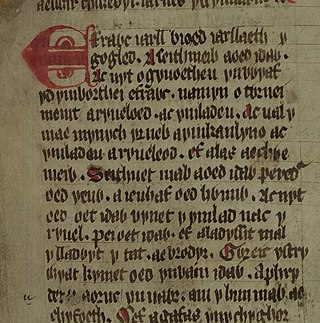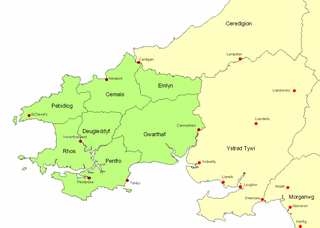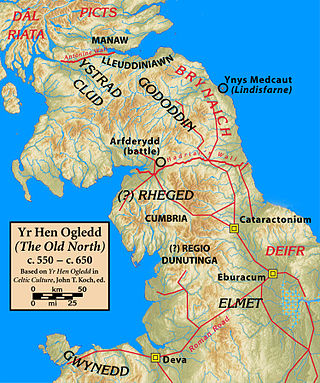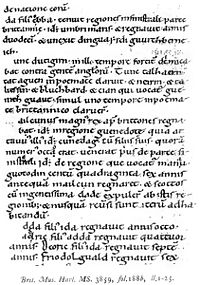
Maelgwn Gwynedd was King of Gwynedd during the early 6th century. Surviving records suggest he held a pre-eminent position among the Brythonic kings in Wales and their allies in the "Old North" along the Scottish coast. Maelgwn was a generous supporter of Christianity, funding the foundation of churches throughout Wales and even far beyond the bounds of his own kingdom. Nonetheless, his principal legacy today is the scathing account of his behavior recorded in De Excidio et Conquestu Britanniae by Gildas, who considered Maelgwn a usurper and reprobate. The son of Cadwallon Lawhir ap Einion and great-grandson of Cunedda, Maelgwn was buried on Ynys Seiriol, off the eastern tip of Anglesey, having died of the "yellow plague"; quite probably the arrival of Plague of Justinian in Britain.

The Annales Cambriae is the title given to a complex of Latin chronicles compiled or derived from diverse sources at St David's in Dyfed, Wales. The earliest is a 12th-century presumed copy of a mid-10th-century original; later editions were compiled in the 13th century. Despite the name, the Annales Cambriae record not only events in Wales, but also events in Ireland, Cornwall, England, Scotland and sometimes further afield, though the focus of the events recorded especially in the later two-thirds of the text is Wales.

Cadwaladr ap Cadwallon was king of Gwynedd in Wales from around 655 to 664 or 682. He died in one of two devastating plagues that happened in 664 and in 682. Little else is known of his reign.

Peredur is the name of a number of men from the boundaries of history and legend in sub-Roman Britain. The Peredur who is most familiar to a modern audience is the character who made his entrance as a knight in the Arthurian world of Middle Welsh prose literature.

Vortiporius or Vortipor was a king of Dyfed in the early to mid-6th century. He ruled over an area approximately corresponding to modern Pembrokeshire, and Carmarthenshire, Wales. Records from this era are scant, and virtually nothing is known of him or his kingdom. The only contemporary information about Vortiporius comes from the Welsh ecclesiastic Gildas, in a highly allegorical condemnation from his De Excidio et Conquestu Britanniae. At the time the work was written, Gildas says that Vortiporius was king of Dyfed, that he was grey with age, that his wife had died, and that he had at least one daughter.
Cadfan ap Iago was King of Gwynedd. Little is known of the history of Gwynedd from this period, and information about Cadfan and his reign is minimal.
Iago ap Beli was King of Gwynedd. Little is known of him or his kingdom from this early era, with only a few anecdotal mentions of him in historical documents.
Beli ap Rhun was King of Gwynedd. Nothing is known of the person, and his name is known only from Welsh genealogies, which confirm that he had at least two sons. He succeeded his father Rhun Hir ap Maelgwn as king, and was in turn succeeded by his son Iago. Beli was either the father or grandfather of Saint Edeyrn.
Rhun ap Maelgwn Gwynedd, also known as Rhun Hir ap Maelgwn Gwynedd, sometimes spelt as 'Rhûn', was King of Gwynedd. He came to the throne on the death of his father, King Maelgwn Gwynedd. There are no historical records of his reign at this early age. A story preserved in both the Venedotian Code and an elegy by Taliesin says that he waged a war against Rhydderch Hael of Alt Clut and the kings of Gododdin or Manaw Gododdin. The small scattered settlement of Caerhun in the Conwy valley is said to be named for him, though without strong authority. Rhun also appears in several medieval literary stories, as well as in the Welsh Triads. His wife was Perwyr ferch Rhûn "Ryfeddfawr" and their son was Beli ap Rhun "Hîr".
Idwal Iwrch, or Idwal ap Cadwaladr, reigned c. 682 – c. 720, is a figure in the genealogies of the kings of Gwynedd. He was the son of King Cadwaladr and the father of King Rhodri Molwynog. William Wynne places Cynan Dindaethwy as his son, but other sources have Cynan as the son of Rhodri. The records of this era are scanty, and Idwal's name appears only in the pedigrees of later kings and in a prophecy found in two 14th century Welsh manuscripts, which says that he will succeed his father Cadwaladr as king.

Rhodri Molwynog, also known as Rhodri ap Idwal was an 8th century king of Gwynedd. He was listed as a King of the Britons by the Annals of Wales.

Caradog ap Meirion reigned c. 754 – c. 798, died c. 798, was a king of Gwynedd in North West Wales. This Welsh name means Caradog son of Meirion.
Cynan Dindaethwy or Cynan ap Rhodri was a king of Gwynedd in Wales in the early Middle Ages. Cynan was the son of Rhodri Molwynog and ascended to the throne of Gwynedd upon the death of King Caradog ap Meirion in 798. His epithet refers to the commote of Dindaethwy in the cantref Rhosyr. Unlike later kings of Gwynedd, usually resident at Aberffraw in western Anglesey, Cynan maintained his court at Llanfaes on the southeastern coast. Cynan's reign was marked by a destructive dynastic power struggle with a rival named Hywel ap Caradog, usually supposed to be his brother.

Merfyn Frych, also known as Merfyn ap Gwriad and Merfyn Camwri, was King of Gwynedd from around 825 to 844, the first of its kings known not to have descended from the male line of King Cunedda.

Hywel ap Caradog was King of Gwynedd. He rose to power following a destructive dynastic struggle in which he deposed King Cynan Dindaethwy. During Hywel's reign, Gwynedd's power was largely confined to Anglesey. It was a time of substantial territorial loss to Mercia.

Manaw Gododdin was the narrow coastal region on the south side of the Firth of Forth, part of the Brythonic-speaking Kingdom of Gododdin in the post-Roman Era. It is notable as the homeland of Cunedda prior to his conquest of North Wales, and as the homeland of the heroic warriors in the literary epic Y Gododdin. Pressed by the Picts expanding southward and the Northumbrians expanding northward, it was permanently destroyed in the 7th century and its territory absorbed into the then-ascendant Kingdom of Northumbria.
The genealogies from Jesus College MS 20 are a medieval Welsh collection of genealogies preserved in a single manuscript, Oxford University, Bodleian Library, Jesus College, MS 20, folios 33r–41r. It presents the lineages of a number of medieval Welsh rulers, particularly those of south Wales. The manuscript was compiled in the late 14th century, but many genealogies are thought to be considerably older. The latest pedigrees to have been included in the tract are those of Llywelyn ab Iorwerth and Rhys Gryg. It shares some material with the earlier Harleian genealogies.

Aeron was a kingdom of the Brythonic-speaking Hen Ogledd, presumed to have been located in the region of the River Ayr in what is now southwestern Scotland. It existed during the post-Roman era, perhaps earlier, and disappeared before or during the 7th-century conquest of the region by the ascendant Kingdom of Northumbria.
Rhodri ab Idwal was a 10th-century prince of Gwynedd from the royal dynasty of Aberffraw.

This is a bibliography of published works on the history of Wales. It includes published books, journals, and educational and academic history-related websites; it does not include self-published works, blogs or user-edited sites. Works may cover aspects of Welsh history inclusively or exclusively.










